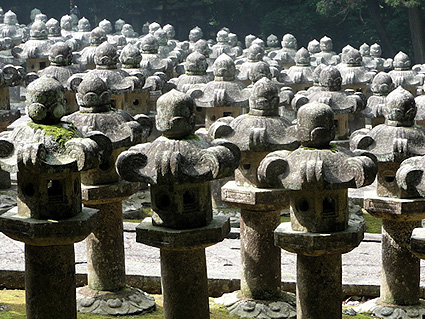Traditional Industries of Kyoto The Art of Stone Carving
Kyoto The Art of Stone Carving: Stone working began in Japan during the Tumulus Period and developed with the introduction and spread of Buddhism.
Traditional Industries of Kyoto The Art of Stone Carving 石工
Stone working is believed to have begun in Japan during the Tumulus Period and developed with the introduction and spread of Buddhism throughout Japan.
Good quality granite mined in the Mt. Hiei and Shirakawa sections of Kyoto, combined with the spare aesthetic of the tea ceremony, resulted in the development of a highly refined stone working culture in Kyoto. The center of much of the Japanese stone working world continues to live on in Kyoto. The relationship between people and stone can be traced back to the Stone Age (Paleolithic Period) but stone was used then primarily to make implements for daily life. According to the late Masataro Kawakatsu, the oldest reference to stonemasonry as a vocation appears in the Kojiki (records of Ancient Matters) and in a chapter of the "Shinsen Seishiroku" where it is written that "in the reign of the Emperor Suishin, a stone coffin was made and presented to the Empress, and for this the maker was granted the name Ishisakube-Renko." Following the transfer of the capital to Kyoto, stone workmanship played a key role in the building of the Imperial Palace (Gosho). Though soft stone was in general use at this time, granite was employed for the foundation stones and some parts of the structure. Later, under the flourishing expansion of Japanese Buddhism, importance was attached to stone as a material of special religious significance. As part of this process, stone working tools were developed, resulting in new kinds of stonemasonry, stone Buddhist images, stone towers, stepping stones and stone lanterns. The Kamakura Period, in particular, is regarded as the formative period for stone (and wood) sculpture and work. With the rise of tea ceremony culture, new stone working techniques and designs appeared. Devotees of the tea ceremony found 'wabi' (a taste for the simple and quiet) and 'sabi' (a taste for the old and timeless patina of beauty) in the world of old stonework. Given that the relics of the past could not meet the demands of the growing culture of tea ceremony, work in stone lanterns, water basins, and multi-tiered ceremonial towers flourished, especially in Kyoto. Today, the members of the Kyoto Stone Industry Cooperative Association (established in 1891) play an important role in supplying the special landscaping and ceremonial requirements of Kyoto's many gardens and cemeteries.










